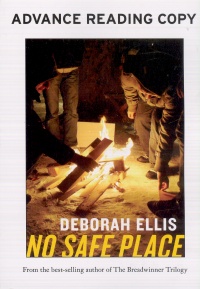| ________________
CM . . .
. Volume XVII Number 1. . . .September 3, 2010
excerpt:
As always, Deborah Ellis has chosen a timely topic upon which to base her latest novel - the harrowing journeys of child migrants. No Safe Place tells the story of three orphaned children and their difficult but ultimately successful attempt to reach the United Kingdom. Fifteen-year-old Abdul has spent four months getting from Baghdad, Iraq, to Calais, France, where he finds a boat to take him across the English Channel. Also on the boat are the Romani girl. Rosalia, who is escaping forced prostitution, and the Russian boy Cheslav, a runaway from the army who hopes to make it to New Orleans in the US so that he can live out his dream to play jazz trumpet with great musicians. The focus of No Safe Place is the children's adventure-filled journey across the Channel, a present-day focused narrative line that alternates between chapters explaining how each child ended up on the boat. No Safe Place has an exciting plot, and it is admirable for its insistent portrayal of children as capable agents of their own destinies, who can effectively take responsibility for themselves. Another highlight of the story is its deeply satisfying ending, as close to happy as this tale could realistically be. On the other hand, a frequent tendency in the narrative is "telling" rather than "showing." In only 208 pages, Ellis attempts to flesh out the stories of several central characters, alternating between the present and the past. The overall feel is that of a massive, sweeping tale skipped over and squeezed into a stilted, skimpy text, something akin to a folktale, perhaps. While this approach is workable in a folktale, it is less successful in a work of fiction. Consequently, there is something rather hollow about No Safe Place that renders it much less gripping and compelling than Ellis's best-known work, The Breadwinner. It is also similar to a folktale in its simple vocabulary and sentence structure. While the publisher recommends this novel for young adult readers, these and other qualities indicate that it is better suited to younger readers aged nine to twelve, although its subject matter may position it as Hi-Lo.
Recommended. Michelle Superle teaches in the Children's Studies Program at York University.
To comment
on this title or this review, send mail to cm@umanitoba.ca.
Copyright © the Manitoba Library Association. Reproduction for personal
use is permitted only if this copyright notice is maintained. Any
other reproduction is prohibited without permission.
NEXT REVIEW |
TABLE OF CONTENTS FOR THIS ISSUE
- September 3, 2010.
AUTHORS |
TITLES |
MEDIA REVIEWS |
PROFILES |
BACK ISSUES |
SEARCH |
CMARCHIVE |
HOME |
